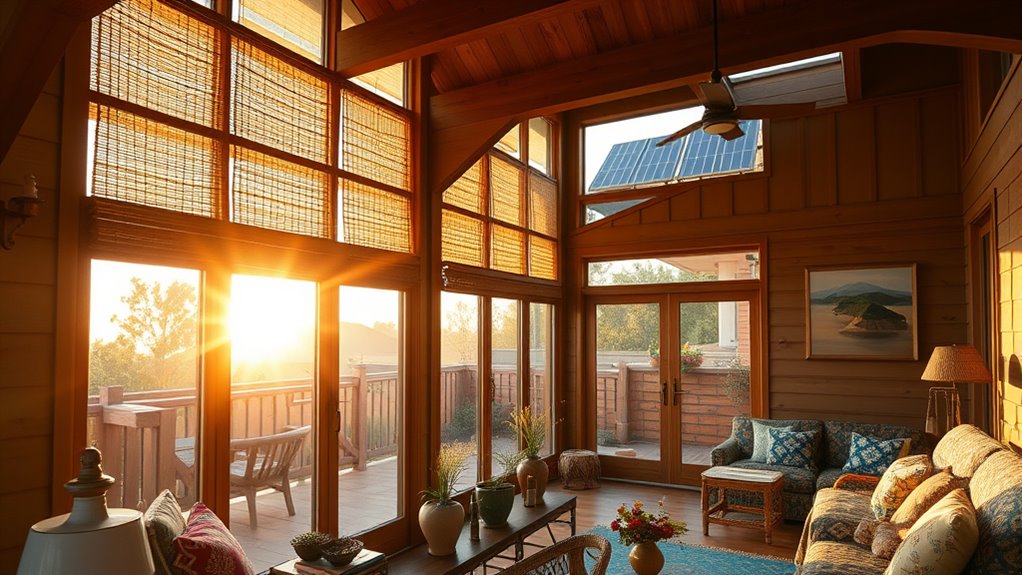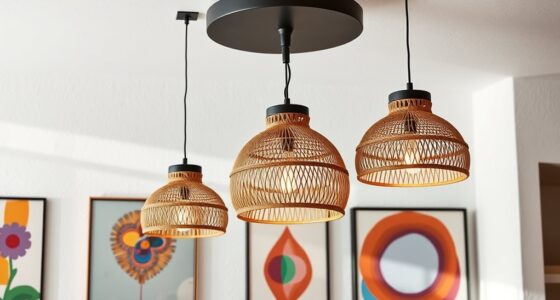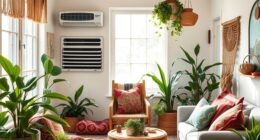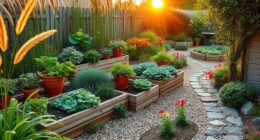To incorporate passive solar design into your boho home, focus on strategic window placement—large south-facing windows for winter warmth and shading for summer—while using natural materials like brick or concrete as thermal mass. Arrange furniture to maximize sunlight, and choose light, diffused curtains that suit your eclectic style. Combining these elements helps create a cozy, eco-friendly space that stays comfortable year-round. Keep exploring to discover how these ideas come together seamlessly.
Key Takeaways
- Use large south-facing windows to maximize winter sunlight and warmth in boho interiors.
- Incorporate thermal mass materials like brick or polished concrete floors to absorb and slowly release heat.
- Install light-colored, natural fabric curtains to diffuse sunlight and enhance passive solar heating.
- Arrange furniture and thermal mass elements strategically to optimize heat distribution and comfort.
- Combine window shading and placement strategies to prevent overheating while maintaining boho aesthetic appeal.

Have you ever wondered how boho homes effortlessly blend style with sustainability? It’s all about smart design choices that harness natural energy, reducing your reliance on artificial heating and cooling. One of the key elements in passive solar design is understanding how thermal mass works. Thermal mass refers to materials in your home—like concrete, brick, or stone—that absorb heat during the day and release it slowly when temperatures drop. In a boho home, you can incorporate these materials into floors or walls without sacrificing aesthetic appeal. Think of a polished concrete floor or a rustic brick accent wall that adds character while helping regulate indoor temperatures. These elements store solar energy, making your space more comfortable year-round and less dependent on external energy sources.
Another essential aspect is window placement. The way you position your windows can considerably influence how much sunlight enters your home and when. In boho homes, large south-facing windows are ideal because they allow maximum sunlight during the colder months, warming your interior naturally. During summer, strategic shading—like overhangs or curtains—prevents overheating. You might also use smaller or higher windows on the north side to minimize heat loss. The placement isn’t just functional; it’s also a design statement, blending with the eclectic, layered style typical of boho interiors. Combining window placement with the right use of thermal mass can create a home that feels warm and inviting in winter and cool in summer, all while reducing your carbon footprint.
Beyond just the physical elements, think about how your window treatments can complement passive solar goals. Light-colored curtains or sheer fabrics can diffuse sunlight, spreading warmth evenly without creating glare. Using natural materials like linen or woven textiles aligns with the boho aesthetic and enhances your home’s sustainability. Additionally, consider the overall layout—arranging furniture to maximize sunlight exposure and taking advantage of thermal mass materials to distribute heat evenly. These thoughtful details turn passive solar design into an integrated part of your home’s personality.
Frequently Asked Questions
How Does Passive Solar Design Impact Energy Bills?
Passive solar design considerably reduces your energy bills by maximizing natural heat from the sun, leading to notable energy savings. You’ll spend less on heating and cooling, which directly contributes to cost reduction. By strategically placing windows and choosing materials that retain warmth, you create a more efficient home. This smart approach allows you to enjoy lower utility costs while maintaining a comfortable living space year-round.
What Are the Best Orientation Practices for Boho Homes?
Imagine you’re back in the days of old, building a cozy nest. To optimize your boho home, align window placement to face south, capturing sunlight during winter and shading in summer. Use roof angles that maximize solar gain, like a 30-45 degree pitch. This orientation enhances natural warmth and light, reducing energy costs and creating a welcoming, sun-kissed space perfect for your free-spirited lifestyle.
Can Passive Solar Features Be Added to Existing Boho Homes?
Yes, you can retrofit passive solar features into your boho home. The retrofit feasibility depends on your home’s structure, but many updates like adding south-facing windows, thermal curtains, or shading devices can be seamlessly integrated. Focus on aesthetic integration by choosing natural, eclectic materials that match your boho style. These enhancements improve energy efficiency while maintaining your home’s unique, relaxed vibe.
What Materials Enhance Passive Solar Effectiveness in Boho Styles?
You can enhance passive solar effectiveness in boho homes by using natural fibers like wool, jute, and cotton for insulation and window treatments. Recycled materials such as reclaimed wood, glass, and metal add eco-friendly charm while improving heat retention and reflection. These materials not only support a sustainable vibe but also optimize sunlight absorption and natural ventilation, making your space warmer in winter and cooler in summer, perfectly aligning with boho aesthetics.
How Does Climate Influence Passive Solar Design Choices?
Oh, climate’s a real mood swing, isn’t it? It dictates your passive solar choices, so you don’t end up baking in summer or shivering in winter. You’ll want climate adaptability, like adjustable shading or thick walls, to manage seasonal variations. Whether you live in a sunny desert or a chilly coastal area, tailoring your design guarantees your boho haven stays comfy year-round, no matter what Mother Nature throws your way.
Conclusion
By blending passive solar design with boho charm, you create a home that’s both beautiful and energy-efficient. Imagine basking in warm natural light as the sun gently warms your space, reducing your reliance on artificial heating. Isn’t it wonderful to live in a home that nurtures your spirit and the environment? Embrace these principles, and let your boho sanctuary become a cozy, sustainable retreat that truly reflects your free-spirited style.









